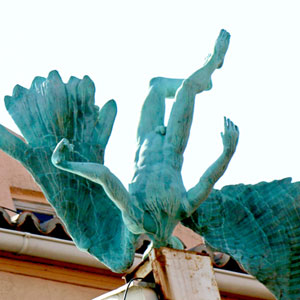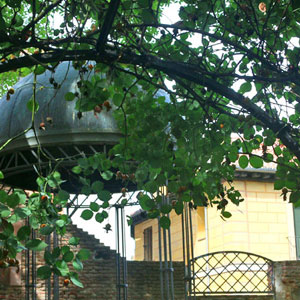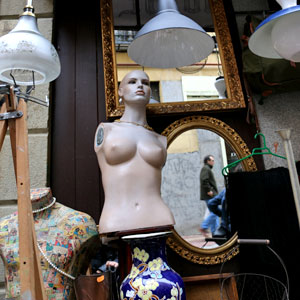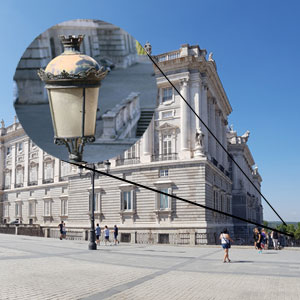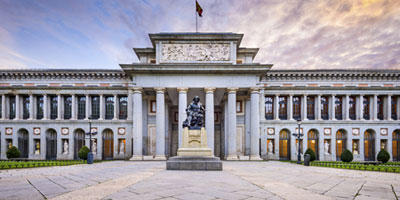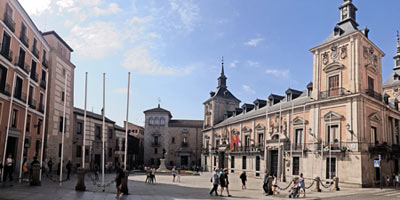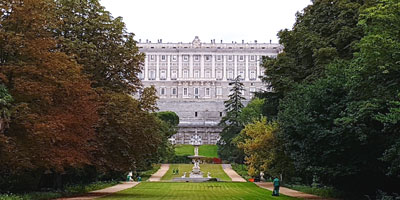The Fallen Angel of Madrid's Retiro
In the Parque del Buen Retiro in Madrid there is a point where the Madrileños stay, the Fuente del Ángel Caído (Fountain of the Fallen Angel). Always crowded with pedestrians, bicycles and skates. It is a well known point of the city, since its inauguration in 1885 by Queen Regent Maria Christina of Hapsburg, his fame has been growing because of the controversial subject of the monument, Satan.
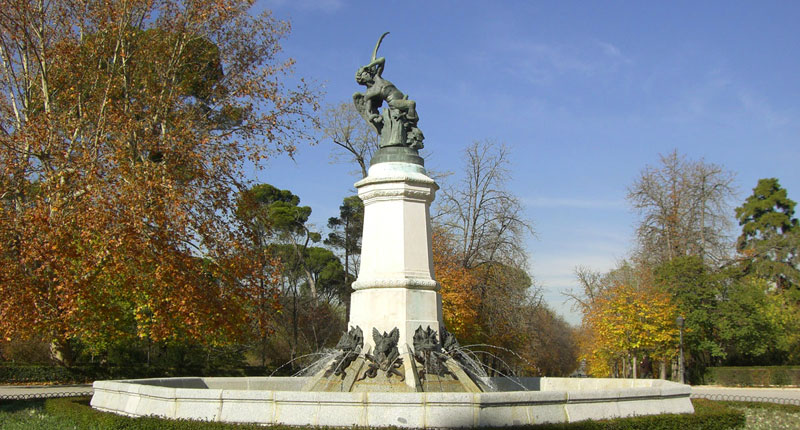
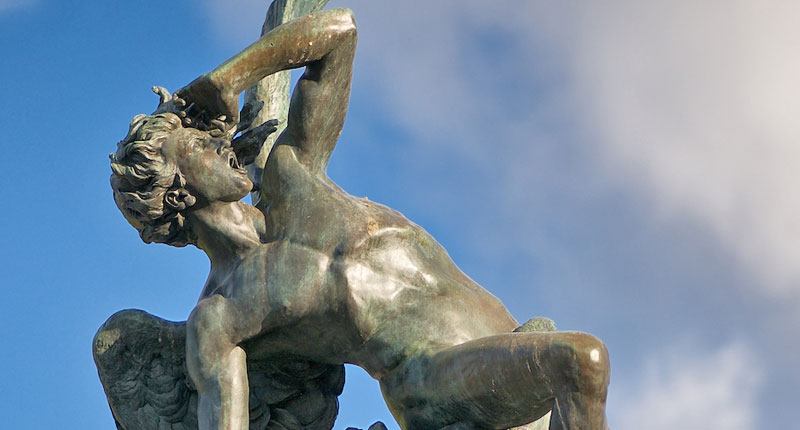
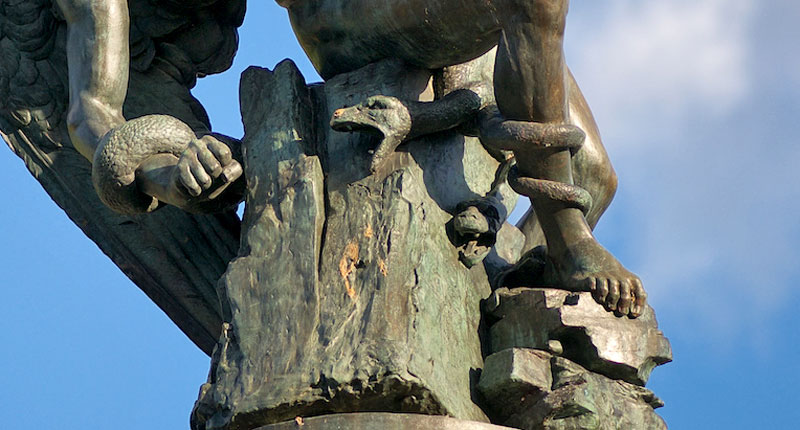
In 1667 The Paradise Lost, a literary masterpiece, was published for the first time, where the Englishman John Milton describes Satan or Fallen Angel of great beauty, the most beautiful and tallest of all angels.
Artists such as William Blake and Gustave Doré will create works where we see a Satan with an athletic body and Hellenic beauty.
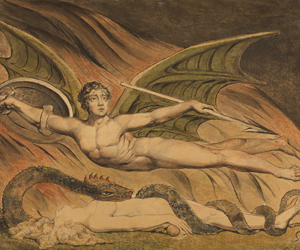
William Brake, Satan Exulting over Eve (1795)

Gustave Doré, Me miserable! (1866)
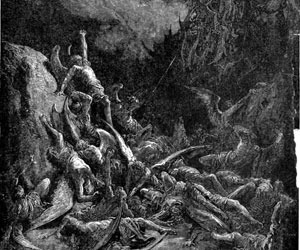
Gustave Doré, Nine days they fell (1866)
In 1878 Ricardo Bellver, 33 years old, presented a sculpture in plaster entitled El Ángel Caído (The Fallen Angel) as a regulatory work for the third year of his pension. It is presented to the National Exhibition of Fine Arts of 1878, in the Catalogue appear fragments of two stanzas of Milton's work:
"For his pride he falls from heaven with all his host of rebellious angels, never to return to it.//// He waves his eyes around, and blasphemously fixes them on the empyrean, reflecting in it the deepest pain, the greatest dismay, the most dismal pride and the most obstinate hatred.
The statue represents Satan expelled from heaven, the Angel who wanted to be God and because of his pride God expelled him. It is a work of romanticism where importance is given to emotions, has a diagonal and unstable composition looking for movement in action with Hellenistic and baroque influences.
Bellver is in Rome influenced by classical sculptures, he sculpts a perfect body, it was the most beautiful angel that God created, leaning on a cut trunk, in tension by the fall, Satan was expelled from heaven and fell for "nine times the space of time that measure the day and night between mortals", with the seven-headed serpent that grabs his legs and right arm. The serpent is Satan himself, it will be the form he takes after his expulsion to tempt humans. In the face an expression that shows stubborn pride and unwavering hatred, all his pride and hatred exposed in the fight against God.
The tree in Milton's work symbolizes life, eternity, duality (good and evil). Nine days Satan was falling into the abyss and he is seated on a tree trunk. It represents the majesty of Satan in defeat as Milton's verses say:
"Thus one sees the oaks of the forest and the pines of the mountain
the mountain when the fire of heaven has deprived them of their bark and greenery, still hold their
majestic trunk, though naked, on scorched moor."
The pedestal and the pylon on which the statue is placed were made by the architect Francisco Jareño y Alarcón when the National Museum, having purchased the work after the National Exhibition and proposed its casting in bronze for the Universal Exhibition of Paris in 1879, considered that its best place would be outdoors where "with more space and horizon would look advantageously the merit of such a beautiful creation".
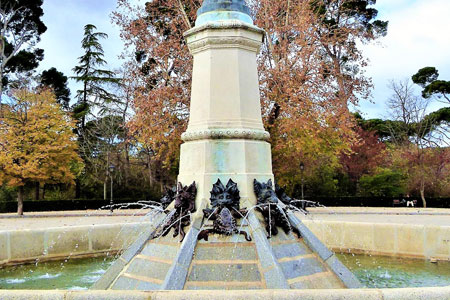
Pedestal with octagonal base in the center of a pylon
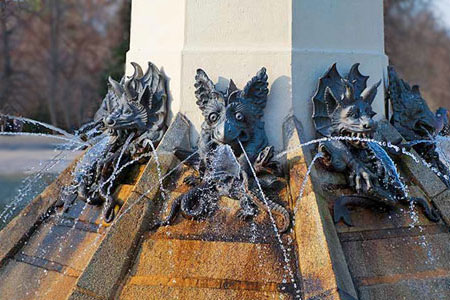
Alternating caratulas of demons that make up the fountain jets
For some, placing the statue of the Fallen Angel on a pedestal and displaying it in a public place creates a monument to the Devil, for others the statue shows the defeat of pride, and others think that it represents freedom of choice, good without evil does not exist, evil is a consequence of our freedom.
Regardless of the meaning we give to the statue, what is certain is that it was involved in controversy since its inauguration, giving fame to it and its author, who curiously never wanted it to leave the National Museum.
Curiosities
1. Non-acclaimed artists will be pleased to know that this work, one of the statues that is today one of the most emblematic of the city of Madrid, had some detractors in its beginnings. It was awarded the second (not the first) gold medal of the national exhibition of 1878 after a very heated discussion with 3 opinions in favor and two against. The national critics of the time were not very favorable, although once it was chosen for the Paris Universal Exposition of 1878, it seems that the criticism died down.
2. Bellver's work in plaster was purchased by the Spanish State for the National Museum of Painting and Sculpture (now the Prado National Museum) for 4,500 pesetas. And 10,000 pesetas were paid for its casting in bronze by the Thiebaut Fils House in Paris with the supervision and remodeling of the waxes by its author. As in almost all bronze reproductions, the plaster model was useless and deteriorated.
3. The fallen angels in the Christian religion are those expelled from heaven for rebelling and disobeying God. The archangel who leads them was called Lucifer or Luzbel - the light bearer - when he rebels he will be called Satan (adversary) or Devil. Milton will always call him Satan.
4. It has been said that the Fallen Angel of Madrid is the only homage to the Devil in the world. In a multitude of lintels, porticos, walls and sculptural scenes the Devil appears, for the sake of clarification, let's say that we are looking for a sculpture where only the Devil is represented. The Devil in the world has many names and forms. For the Christian religion Devil and Fallen Angel are synonyms but for the rest of religions it is not so. So let's ask ourselves if this is the only homage to the Devil in the Christian World. The Devil has many forms, serpent, monster, dragon, and a long etc., so to narrow down the search even more, we can ask ourselves if we will find him represented as an anthropomorphic being anthropomorphic and beautiful.
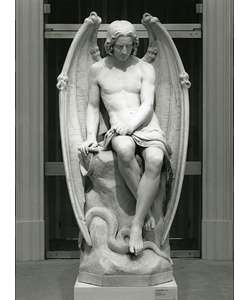
The Angel of Evil, Joseph Geefs, 1842
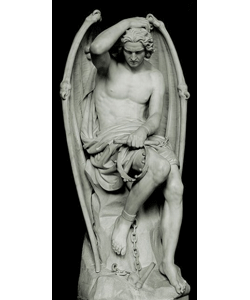
The Genius of Evil, Guillaume Geefs, 1848
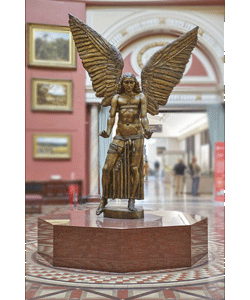
Archangel Lucifer, Jacob Epstein, 1944

Fallen Angel by Salvador Buemi, 1910
The most debatable nuance is which of the sculptures we could call a monument.
Although there is more than one monument to the Fallen Angel, the one in the Retiro Park is unique and special for its beauty and thanks to being able to be admired in such a privileged place.
5. There is a nail next to the fountain, it is at a height above sea level of 666 meters , do not look at it on Google Maps because it does not use Alicante as level 0 meters. It has been believed until recent studies that the 666 was the mark of the Beast. The 6 is the most perfect imperfect number since only 1 is left for the perfect number, the 7.
According to new studies the original mark of the Beast is the 616, so if the fountain was placed at that height on purpose as a wink or maybe looking for the door to hell, it sure does not work.
6. 7 is the perfect number, do you remember how many heads the snake that entangles itself in the Fallen Angel has?
7. Some decades ago satanic sects used to gather at the fountain to perform covens and other rites because they considered the fountain a gateway to hell. With the closing of the Park at night, this custom was lost.
Details
Location
Glorieta del Ángel Caido, Retiro Park
Schedule
Open every day
Spring - Summer: April - September 06:00 - 0:00 h.
Autumn - winter: October - March 06:00 - 22:00 h
Transportation
Retiro Subway
Tags
LATEST ARTICLES
THIS INTEREST YOU
A ROMANTIC GARDEN IN THE CENTER OF MADRID: To enjoy with a book or spend a few moments with your partner in one of the most romantic places in Madrid.....read more
THE PRADO MUSEUM: The most important museum in Madrid, and one of the most important art galleries in the world with more than 35,000 pieces...read more
Most VIEWED
EL MERCADILLO DE MADRID, EL RASTRO: on Sundays and holidays it is full of people, rivers of people who look, bargain and buy in an open-air market with removable stalls....read more
MADRID MUSEUMS GUIDE: This guide is intended as a reference to give you an idea of the museums in Madrid. The museums have been placed according to a thematic criterion even though they are with....read more
THE LAMP OF THE REPUBLIC THAT LIGHTS THE ROYAL PALACE: If you walk along Bailen street in front of the Royal Palace in its north-east corner, the one that faces the Sabatini gardens, and you look at...read more
SOLEMN RELEVO AND CHANGING OF THE GUARD AT THE ROYAL PALACE OF MADRID: You begin to hear a drum and piccolo music, people are milling around in front of the Prince's Gate of the Royal Palace, in front of the square of the Royal Palace....read more
Activities that may interest you...
Let us tell you the stories behind them and how to interpret artistically the paintings of Goya, Velazquez, Rubens, El Bosco...
We will visit the old Madrid, its historic center, the part of the city that flourished with the house of the Austrias, the most requested tour!
Free
Indispensable if you visit Madrid. The Royal Armory, the Sabatini staircase, the Crown room, the throne room are not to be missed.


